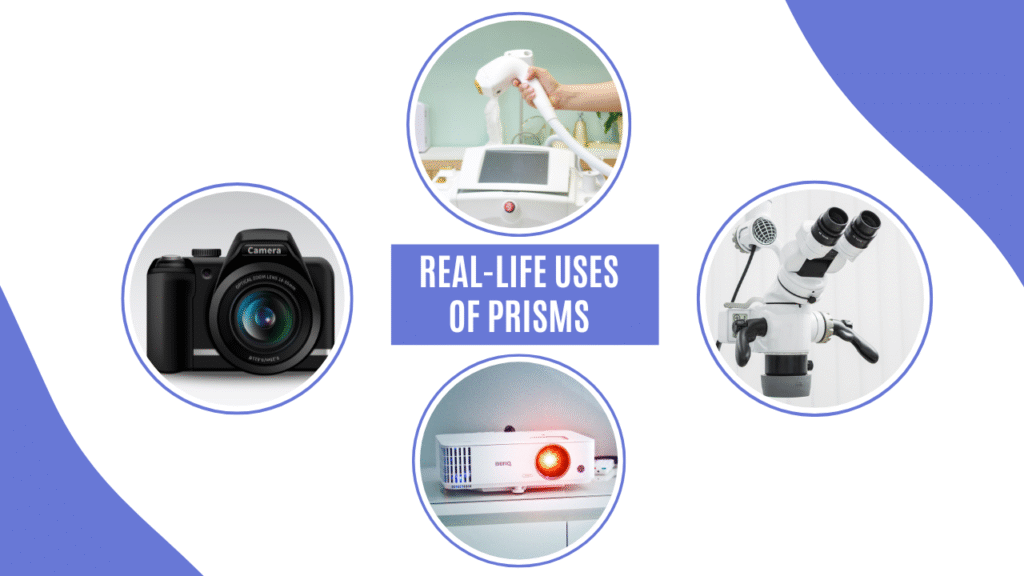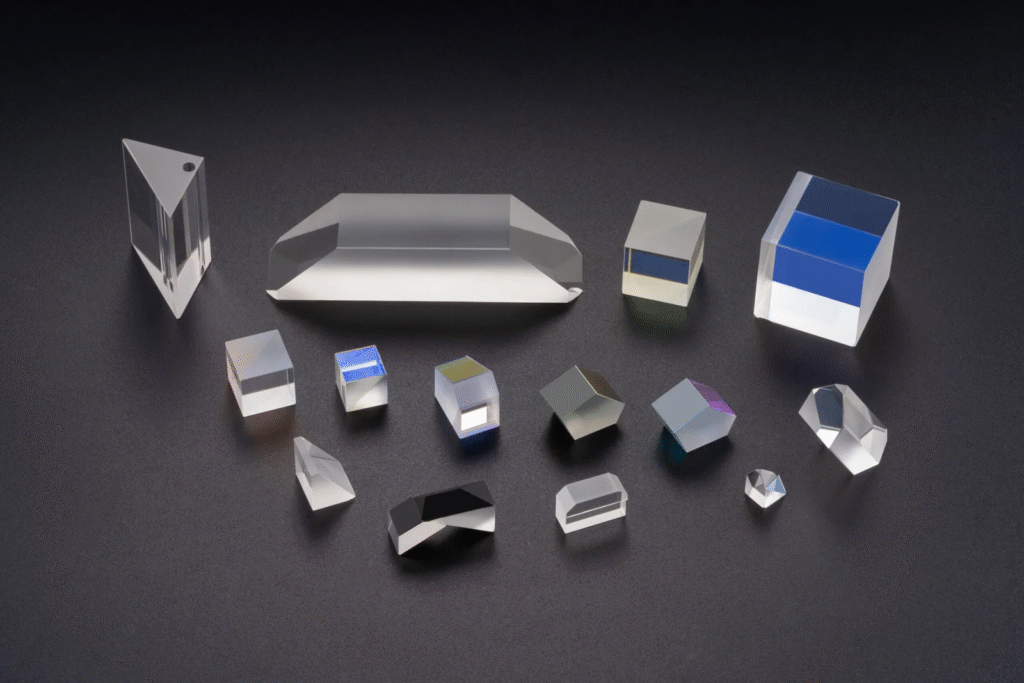Light is an important part of our everyday life. It helps us see, communicate, and explore the world around us. But have you ever wondered why light sometimes forms a rainbow of colors when it passes through certain objects? This fascinating effect happens with a tool called a prism. A prism is a transparent solid, usually made of glass or plastic, that can bend and split light into its natural colors.
The way a glass optical element works is based on a simple scientific concept called refraction. When light enters this transparent medium, it slows down and bends due to the change in material—from air to glass. This bending is not the same for every color of light, which is why a prism spreads white light into a band of colors known as a spectrum. The science behind prisms was first explored by Isaac Newton in the 17th century, and his experiments proved that white light is made up of multiple colors.
In this guide, we will explain how prisms are not just scientific instruments but are also widely used in cameras, binoculars, lasers, and even medical equipment.
How Does a Prism Work?
A prism is a transparent solid (usually glass or plastic) with flat, polished faces. When white light enters it, the light slows down and bends. Inside the optical element, each color in white light travels at a slightly different speed, causing each color to bend by a different amount.When the light exits, the colors spread out. This split into colors is called dispersion. In short: enter → bend → spread → exit as a spectrum.
Why Light Bends in an Optical Element
Light changes speed when it moves from one medium to another (air → glass → air). This change in speed makes it change direction, a process called refraction. Because each color (wavelength) has a different speed inside glass, they refract by different angles.
Quick table: refractive index and bending
| Medium | Typical Refractive Index (n) | Light Speed vs. Vacuum | Effect on Light |
|---|---|---|---|
| Air | ~1.0003 | Almost unchanged | Tiny bend |
| Water | ~1.33 | Slower | Moderate bend |
| Glass | ~1.5 (varies by type) | Slower | Stronger bend |
Key points:
- Higher index → more slowing → more bending
- Shorter wavelength (violet) → bends more
- Longer wavelength (red) → bends less
Types of Prisms
Different prism shapes and materials give different optical jobs.
Main types (with uses):
| Prism Type | What It Mainly Does | Typical Use Case |
|---|---|---|
| Dispersive prism | Splits white light into colors | Spectrometers, teaching optics |
| Reflective prism | Reflects and flips images internally | Binoculars, periscopes, cameras |
| Polarizing prism | Separates or filters light polarization | Microscopes, photography, sunglasses |
| Beam-splitting prism | Splits one beam into two or more beams | Laser systems, optical metrology |
| Right-angle prism | Turns light path by 90° or 180° | Imaging systems, rangefinders |
| Equilateral prism | Common for dispersion experiments | Classrooms, labs |
Real-Life Uses of Prisms

Prisms quietly power many tools you see or use:
- Cameras and binoculars: flip and straighten images.
- Spectrometers: split light to study materials.
- Fiber optics and lasers: steer, split, or combine beams.
- Vision therapy lenses: shift images for people with double vision.
- Projectors and scanners: align and manage light paths.
- Polarized sunglasses: reduce glare using polarizing prisms/films.
Functions VS. Device
| Function | Device/Field |
|---|---|
| Image inversion | Binoculars, periscopes |
| Light splitting | Spectrometers, laser labs |
| Polarization control | Microscopes, sunglasses |
| Beam steering | Industrial laser cutters |
| Wavelength analysis | Astronomy, chemistry labs |
How a Prism Forms a Rainbow
- White light enters the prism.
- It slows and bends (refraction).
- Different colors bend by different amounts (dispersion).
- Light exits as a spread of colors (spectrum: red to violet).
Color order (longest → shortest wavelength):
Red, Orange, Yellow, Green, Blue, Indigo, Violet (ROYGBIV).
Important Concepts Behind Prism Work
| Term | Simple Meaning |
|---|---|
| Refraction | Bending of light when it changes medium |
| Dispersion | Splitting of white light into its component colors |
| Spectrum | The color band from red to violet |
| Wavelength | Distance between light waves; decides color and bending |
| Refractive Index | How much a material slows light (higher = more bending) |
| Incident Ray | Light entering the prism |
| Emergent Ray | Light leaving the prism |
| Deviation Angle | Total angle the beam changes direction inside the prism |
Common Misconceptions About Prisms
- Prisms create colors : No. Prisms only separate colors already in white light.
- All prisms split light : No. Some prisms only reflect or redirect light.
- Only glass works : Plastic and crystals can also be used.
- Red bends the most : Violet bends the most; red bends the least.
- Any triangle block is a prism : Only if it’s transparent and has polished faces for optical use.
How to Try a Prism Experiment at Home
You need: a small glass (or plastic) triangular prism, a flashlight or sunlight, and a white sheet of paper.
Steps:
- Darken the room (if using a flashlight).
- Shine the light through one face of the prism.
- Hold the paper behind the prism to catch the colors.
- Tilt and rotate the prism slowly until a clear spectrum appears.
- Note how moving the prism changes the spread and brightness.
What to observe:
- The order of colors.
- The amount of spread when you change angles.
- The effect of different light sources (sun vs. LED).
How Prisms Help in Scientific Research

- Astronomy: Prisms in spectrographs split starlight to reveal elements and temperature.
- Chemistry: Spectrometers read emission/absorption lines to identify substances.
- Physics: Prisms help measure refractive index, dispersion, and polarization effects.
- Environmental testing: Optical analyzers use prisms to detect pollutants via light absorption.
- Material science: Prisms help evaluate coatings, lenses, and optical fibers.
Role of Optical Components in Medical and Industrial Uses
Medical:
- Prism glasses shift visual images to treat diplopia (double vision) or eye alignment problems.
- Ophthalmic instruments use prisms to measure eye deviation angles.
Industrial:
- Laser alignment systems use prisms to direct beams accurately.
- Metrology tools (measuring tools) use prisms for precise angle and beam control.
- Machine vision systems use prisms to fold optical paths in tight spaces.
Benefits of Using Prisms
- Passive: no power needed.
- Accurate: predictable bending based on refractive index and angles.
- Durable: glass/plastic lasts long with good polishing.
- Versatile: reflect, split, combine, polarize, or analyze light.
- Educational: easy to demonstrate refraction and dispersion.
Wrap up
In this guide, we have explained what a prism is, how it works, and why it plays such an important role in understanding light. An optical element may appear to be a simple piece of glass or plastic, but it uncovers the hidden nature of white light by bending and separating it into a spectrum of colors through refraction and dispersion. From scientific research to everyday tools like cameras, binoculars, and laser devices, prisms are everywhere, silently performing their tasks. They also help in medical fields, vision correction, and industrial applications, showing their versatility.
Learning about optical elements is not only useful for students but also for anyone curious about how light behaves. By experimenting with a small glass block at home, you can observe the same phenomenon that Isaac Newton once studied. Prisms will continue to be a simple yet powerful tool in both science and technology.

